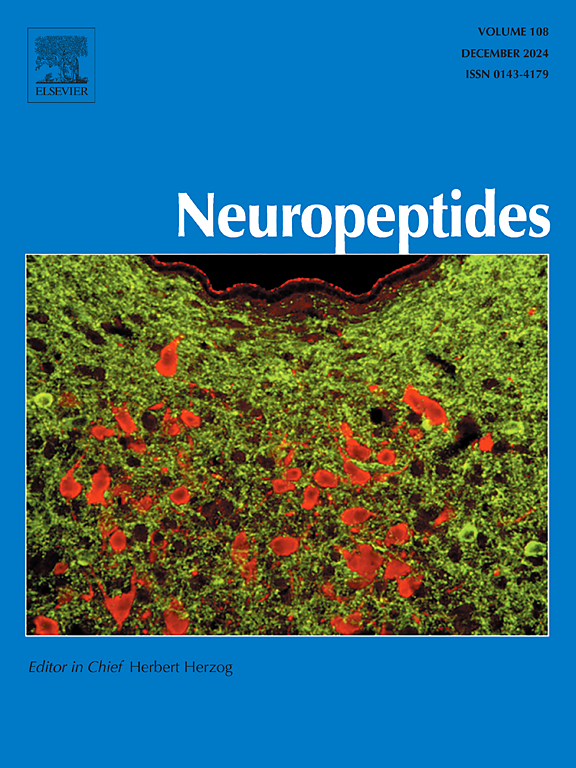The effects of corticotropin-releasing factor (CRF) and urocortins on the serotonin (hydroxytryptamine, 5HT) released from the raphe nuclei (RN)
IF 2.7
3区 医学
Q3 ENDOCRINOLOGY & METABOLISM
引用次数: 0
Abstract
Corticotropin-releasing factor (CRF) and urocortins (UCN1, UCN2 and UCN3) belong to the same CRF family of neuropeptides. They regulate the neuroendocrine, autonomic and behavioral responses to stress via two CRF receptors (CRF1 and CRF2). Stress, anxiety and depression affects the activity of the hypothalamic-pituitary-adrenal (HPA) axis and the serotoninergic neurotransmission, both being regulated by CRF and CRF-related peptides. However, the exact action of CRF and urocortins on the serotonin (5-hydroxytryptamine, 5HT) release was not fully elucidated yet. Therefore, the aim of the present study was to investigate the actions of CRF and urocortins on the 5HT released from the rat raphe nuclei (RN), the most important brain regions producing 5HT, and the participation of CRF receptors in these actions. In order to do so, male Wistar rats were used, their RN were isolated and dissected, and the RN slices were incubated with tritium-labelled 5HT, superfused and stimulated electrically. During superfusion, the RN slices were treated with CRF, UCN1, UCN2 or UCN3, and, when significant effect was observed, pretreated with selective CRF1 antagonist antalarmin or selective CRF2 antagonist astressin2B. The release of tritium-labelled 5HT from the RN was determined by liquid scintillation counting. CRF and UCN1 decreased significantly the tritium-labelled 5HT release from the RN, and these effects were reversed by antalarmin, but not by astressin2B. In addition, UCN3, but not UCN2, increased significantly the tritium-labelled 5HT release from the RN, and this effect was reduced by astressin2B, but not antalarmin. Our results indicate the existence of two apparently opposing CRF systems in the RN: activation of CRF1 by CRF and UCN1 may inhibit, whereas activation of CRF2 by UCN3 may stimulate the 5HT release. The dysbalance between CRF1 and CRF2 activation and, consequently, alteration of serotoninergic signalling may result in anxiety and depression, associated with hyperactivity of the HPA axis.
促肾上腺皮质激素释放因子(CRF)和尿皮质素对中脑核(RN)释放血清素(羟色胺,5HT)的影响。
促肾上腺皮质激素释放因子(CRF)和尿皮质素(UCN1、UCN2和UCN3)属于同一个CRF神经肽家族。它们通过两个CRF受体(CRF1和CRF2)调节神经内分泌、自主神经和对压力的行为反应。应激、焦虑和抑郁影响下丘脑-垂体-肾上腺(HPA)轴的活动和血清素能神经传递,两者都受CRF和CRF相关肽的调节。然而,CRF和尿皮质素对血清素(5-羟色胺,5HT)释放的确切作用尚未完全阐明。因此,本研究的目的是研究CRF和尿皮质素对大鼠中隔核(RN)释放5HT的作用,以及CRF受体在这些作用中的参与。中隔核是产生5HT的最重要的脑区。为此,使用雄性Wistar大鼠,分离并解剖其RN,将RN切片与氚标记的5HT孵育,并进行超灌注和电刺激。在灌注过程中,分别用CRF、UCN1、UCN2或UCN3处理RN切片,当观察到有显著效果时,再用选择性CRF1拮抗剂安talarmin或选择性CRF2拮抗剂astressin2B预处理。通过液体闪烁计数测定氚标记的5HT从RN的释放量。CRF和UCN1显著降低了RN中氚标记的5HT的释放,这些作用被安塔拉明逆转,但不被应激素2b逆转。此外,UCN3显著增加了RN中氚标记的5HT的释放,而UCN2则没有,并且这种作用被astressin2B而不是antalarmin所降低。我们的研究结果表明,在RN中存在两种明显相反的CRF系统:CRF和UCN1激活CRF1可能会抑制,而UCN3激活CRF2可能会刺激5HT的释放。CRF1和CRF2激活之间的失衡以及由此引起的5 -羟色胺能信号的改变可能导致焦虑和抑郁,并与HPA轴的过度活跃有关。
本文章由计算机程序翻译,如有差异,请以英文原文为准。
求助全文
约1分钟内获得全文
求助全文
来源期刊

Neuropeptides
医学-内分泌学与代谢
CiteScore
5.40
自引率
6.90%
发文量
55
审稿时长
>12 weeks
期刊介绍:
The aim of Neuropeptides is the rapid publication of original research and review articles, dealing with the structure, distribution, actions and functions of peptides in the central and peripheral nervous systems. The explosion of research activity in this field has led to the identification of numerous naturally occurring endogenous peptides which act as neurotransmitters, neuromodulators, or trophic factors, to mediate nervous system functions. Increasing numbers of non-peptide ligands of neuropeptide receptors have been developed, which act as agonists or antagonists in peptidergic systems.
The journal provides a unique opportunity of integrating the many disciplines involved in all neuropeptide research. The journal publishes articles on all aspects of the neuropeptide field, with particular emphasis on gene regulation of peptide expression, peptide receptor subtypes, transgenic and knockout mice with mutations in genes for neuropeptides and peptide receptors, neuroanatomy, physiology, behaviour, neurotrophic factors, preclinical drug evaluation, clinical studies, and clinical trials.
 求助内容:
求助内容: 应助结果提醒方式:
应助结果提醒方式:


